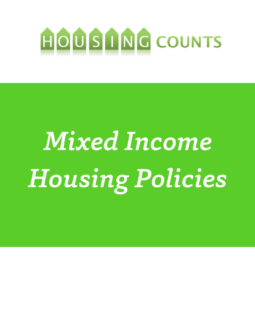Adopt Mixed Income Housing Policies
Mixed income housing policies are flexible tools for creating new affordable rental and ownership opportunities in connection with market-rate housing development. Mixed income housing policies may be mandatory or voluntary, and either require or offer incentives for developers of market-rate projects to set aside a modest percentage of units for low- and moderate-income households. Many ordinances require below-market units to be built at the same time, in the same location, and with an appearance similar or identical to the adjacent market-rate units, helping to create diverse, mixed income neighborhoods and disperse affordable homes throughout the community. Mixed income housing policies increase the availability of affordable homes by requiring (or encouraging through incentives) developers of new residential buildings or subdivisions to set aside a modest portion of homes for low- and moderate-income families. While there are some basic elements that all policies cover, the specific terms of mixed income housing policies are relatively flexible and may be tailored to address local housing needs and market conditions. These policies have been utilized by cities and counties throughout the country since the early 1970s. They typically do not provide housing affordable to extremely low income households, but rather those with incomes starting at 50% of area median income (AMI) or higher. There currently are nearly 500 voluntary and mandatory inclusionary policies in active use. Explore the new National Housing Conference’s Housing Policy Guide that provides a basic overview of key affordable housing policies and programs and this new Policy Toolkit for Inclusive Growth to help communities understand their housing policy options and the approach that will work best for them.
What are problems does this policy solve?
Communities adopt mixed income housing policies primarily to increase new housing opportunities for moderate-income families. However, these policies can also help stem displacement of existing residents in neighborhoods undergoing redevelopment, where the cost of housing increases to levels that are unaffordable to current residents.In addition to increasing the overall supply of affordable homes, mixed income housing policies can play a role in alleviating the “spatial mismatch” that occurs in many high-cost areas when local housing prices rise out of reach of low-wage workers who serve the community. By ensuring that a portion of newly created homes are affordable to working families, mixed income policies allow workers to access opportunity- and amenity-rich neighborhoods and avoid long commutes from areas with lower housing costs.Mixed income policies are particularly relevant where cities plan on upzoning, and consideration of mandatory or incentive programs should be an important part of planning efforts as outlined in a 2014 report by the Center for Housing Policy, Inclusionary Upzoning: Tying Growth to Affordability.
Mixed income policies have consistently withstood challenges under the U.S. Constitution, including a June 15, 2015 decision by the California Supreme Court. In Minnesota, mixed income housing policies are specifically permitted by Minnesota Statutes Section 462.358 subdivision 11 which authorizes inclusionary zoning policies in the context of city land use approvals.
Minnesota Cities Provide Incentives in Return for Affordability
The City of Chaska Comprehensive Plan calls for 30% of units affordable at 80% AMI in exchange for regulatory flexibility (e.g., density bonuses reduced setbacks or other requirements, fee waivers, expedited processing) in several neighborhoods with significant development opportunities. In practice, the City negotiates affordability levels and tailors assistance packages to those levels. In addition, the City created an affordable housing Tax Increment Financing district which generates funds for the City’s Housing Trust Fund.
The City of Woodbury’s density bonus policy offers bonuses in return for at least 20% of the units affordable at 80% of AMI. The policy was effective in providing affordable housing in several large market rate projects in the last decade, and in one case resulted in inclusion of a low income tax credit project within the project site.
The City of Forest Lake’s policy provides for a 15% density bonus, partial fee waivers and flexible parking requirement in return for developers providing affordable units.
Minnesota Cities Tie Affordability Requirements to the Use of Local Financial Resources
The City of Minneapolis generally requires any housing project with at least 10 units receiving tax increment financing or other funds to provide 20% of the units affordable at or below 50% AMI. The City of St. Louis Park has adopted a policy for developers seeking TIF assistance, requiring 10% affordable at 60% AMI or 8% at 50% AMI (for rental) or 80% AMI for ownership.
Minnesota Cities Tie Affordability to Projects Seeking Land Use Changes
The City of Minnetonka EDA imposes a 10%-20% affordability requirement for projects seeking land use approvals in most cases. Minnetonka also requires 20% of the units affordable at 50% AMI for any projects using TIF. This mixed income housing policy has provided support for targeted, smaller scale projects such as the Ridge.
The City of Edina requires all new multi-family developments of 20 or more units that require a re-zoning to provide a minimum of 10% of all rentable areas affordable at 50% of the area median income or 20% of all rentable areas affordable at 60% of the area median income.
